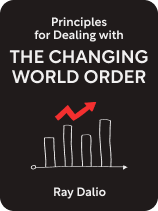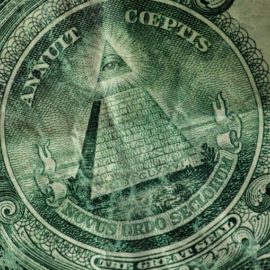

This article is an excerpt from the Shortform book guide to "Principles for Dealing with the Changing World Order" by Ray Dalio. Shortform has the world's best summaries and analyses of books you should be reading.
Like this article? Sign up for a free trial here.
How do societies evolve over time? What causes periods of harmony and disharmony in civilizations?
Ray Dalio explores the cycles of society in his book Principles for Dealing With the Changing World Order. He examines how economic and social factors contribute to the rise and fall of major powers. Dalio argues that societies progress through stages of building harmony and increasing disharmony.
Read on to discover Dalio’s insights into these cycles, including the state of the US and China within them.
Cycles of Society
As these economic cycles unfold, a major power’s civil society develops in particular ways. That society is organized as a sociopolitical system made of spoken and unspoken rules and norms that govern how large groups of people work and live together.
Just like economies, societies fluctuate between periods of harmony and periods of disharmony. In these cycles of society, at times, people generally get along and work well together, and at other times, discord, strife, and conflict tend to arise between classes within a society.
Dalio describes societies as progressing through three stages of building harmony, wherein people cooperate and economic activity flourishes, and three stages of increasing disharmony, wherein civil society degrades and falls apart.
Most sociopolitical cycles end in violence, such as civil war or revolution, which are an inevitable fact of life, Dalio argues. This is because any society benefits a certain small class over most others (such as how capitalism privileges those who own the means of production), so the unprivileged majority eventually becomes dissatisfied with the status quo. Conflict breaks out over values, how to distribute wealth and power, and who should be in charge. Generally, a revolution succeeds when it yields broad economic prosperity for the previously unprivileged.
(Shortform note: The Russian Revolution, a period of intense social unrest and eventually violent conflict in early 1900s Russia, exemplifies Dalio’s cycles of harmony and disharmony. Prior to the 1900s, the Russian Empire had, since the 1700s, exerted relatively nominal control over its various subjects and had multiple popular monarchs who presided over long periods of expansion and prosperity. But later, after a 1905 defeat in the Russo-Japanese War as well as the domestic unpopularity of Russia’s participation in WWI, workers strikes in Petrograd in 1917 snowballed toward violent conflict and the eventual fall of the monarchy.)
Cycles of Society in the US & China
According to Dalio, the US shows strong signs of internal turmoil and may be heading toward more serious fragmentation. Increasing levels of political polarization, values gaps, and financial uncertainty mean that the US could descend into a period of possibly violent restructuring—Dalio suggests a 30% chance of a civil war-like event within 10 to 15 years.
However, he also argues that the US has weathered more political turmoil than most empires do, having persisted through 250 years that saw a civil war, multiple major depressions and world wars, and other major civil conflicts. While Dalio says it would be difficult—given the US’s high international debt, weakened political standing, and high levels of internal conflict—the country could manage by recognizing the decline and aiming for a nonviolent restructuring.
(Shortform note: Various experts and pundits have long thrown around rhetoric to the effect that “the West is in decline,” and that may be true, at least in part. However, John Rapley, one of the authors of Why Empires Fall, argues that the United States, which helms the Western world order, isn’t doomed to disappear. Rather, he says that while America can’t return to the heights of global dominance it held in the decades following WWII, the nation still has abundant power in the form of its huge capital reserves, advanced military, extensive alliances, and cultural soft power. Rather than attempt another era of “America First,” Rapley says that the United States can remain powerful through cooperation and coalition-building with other major world powers.)
China, on the other hand, is presently in a period of peace and prosperity. They have relatively strong economic fundamentals (low debt, high productivity) and a strong civil society with low conflict over values and wealth distribution. While he doesn’t go into great detail, Dalio expresses optimism about China.
(Shortform note: In contrast to Dalio’s assertion that China boasts strong civil society, other experts say that Chinese civil society struggles to define itself as fully apart from the government. In one example, domestic non-governmental organizations (NGOs) tend to end up as governmentally organized NGOs, or GONGOs, since China’s government doesn’t often sanction organized activity that’s outside party control.)

———End of Preview———
Like what you just read? Read the rest of the world's best book summary and analysis of Ray Dalio's "Principles for Dealing with the Changing World Order" at Shortform.
Here's what you'll find in our full Principles for Dealing with the Changing World Order summary:
- How to use patterns in world history to make better decisions today
- What may happen in the near future for the United States and China
- Why humans are stuck in a competition for wealth and power






